In-depth review When Rolex was the king of ‘Sports Elegance’ – Part 1
Fine WatchesCollector's InsightFocus on explorer & star dials
Rolex, today, is the most recognised watch brand on the planet.
It has built up its ‘brand equity’ through producing durable and high-quality sports watches in large quantities. This makes the brand so powerful and recognizable all over the world. But if we go back 70 years to the glamorous 1950’s, Rolex was a completely different animal. They were playing also a large role in elegant watches (that were also sportive) and dominated a niche market.
If you wanted to buy an elegant watch with automatic movement that was waterproof in the late 1940’s and very early 1950’s, only one brand could help you – that was Rolex. They owned a patent on automatic movements (Perpetual rotor) that were also water-resistant (Oyster), and it allowed them dominate a category that I call ‘sports elegance’.
So far, scholars and collectors have left this important part of Rolex history out. Concentrating on Rolex sports watches in steel made sense (after all this is Rolex’s DNA) and this is well covered today. But Rolex led an important niche in the early 1950’s which is not that well documented. A perfect example are the ‘Explorer dial’ watches in gold as well as ‘star dial’ time only watches. These gold watches are not as robust and durable as the steel sports watches that Rolex also made at the time, but Rolex wanted to compete with another segment besides steel sports watches.
This post intends to show Rolex at its height of artistic capabilities and how, in my view, it beat its competitors like Vacheron and Patek (not to mention AP, Breguet, Longines, Eterna or any other high end manufacturer of that time).
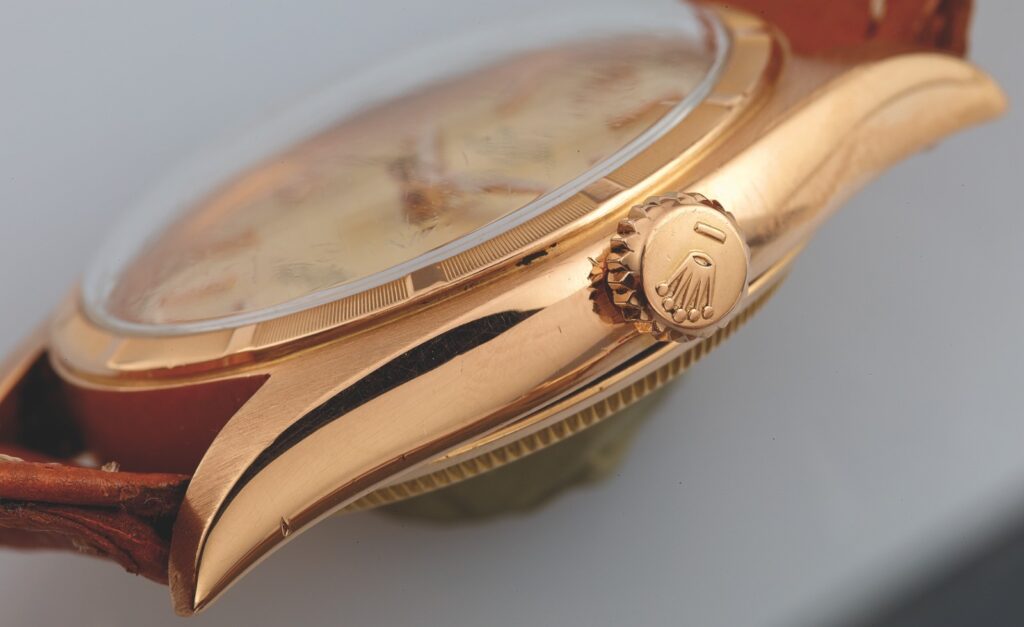
(Profile of the elusive Ref 6099 with explorer dial in pink gold – credit: Parmegiani).
Before we go into explorer and star dials (which is the first part of a 3 part series), let me set the framework for you.
If you think Rolex made it’s first big push into sports watches in the 1950’s, think again. Yes, Rolex’s big sports-push came with the Submariner, GMT, and Explorer in the mid 1950’s and in 1960’s with the Daytona. But Rolex was dabbling into sports watches much earlier, long before the GMT Master, Submariner or Explorer were even born.
Consider this: Already in the 1930s, Rolex was making waterproof watches, one of the earliest Oyster watches, which sits in the Beyer museum in Zurich.
And – how can we forget – the marketing genius of Rolex of choosing Mercedes Gleitze to wear a Rolex Oyster when she became the first women to swim across the English Channel in the 1930s.

(Credit: The history press).
Rolex had already back in the 1930s, two key ingredients, to beat their competitors in making great watches that were sportive and elegant:
First, it had created the world’s first true automatic (perpetual) rotor (1931). Second it had launched the first waterproof wristwatch (also 1930’s). This would set Rolex up very well to introduce a niche that I call ‘sportive elegance’, that started with the Bubblebacks, but ended in the 1950s with the large so called ‘Large Bubblebacks’ Explorer dials and Enamel and black lacquer dials.
Even if Patek (with the the beautiful 2508 or the 565) and Vacheron (the 4301) were very strong competitors to Rolex in the late 1940’s and early 1950’s in creating beautiful but sportive watches – they didn’t have a chance to compete (in my view), if the owner wanted an automatic or self-winding watch that was water-resistant.
Only Rolex was able to deliver this! ‘Oyster Perpetual’ were two powerful words that would set a Rolex watch apart from all the competition. Rolex was not the first to deliver an automatic movement (Harwood was) but Rolex was clever to buy the patents and improve upon them.

(First automatic movement with perpetual rotor from Rolex that turned 360 degrees. Credit: Rolex website)
Rolex & Oyster Perpetual
Rolex with their patent in 1931 (valid for 20 years) essentially ‘blocked’ all competitors from making a wrist-watch with perpetual rotor that was also water-resistant. Eterna, for example, created an automatic movement in 1948 but it wasn’t perpetual and had a limited power reserve. First in 1953 did Rolex see some serious competition with Patek bringing out the much celebrated and beautiful Ref 2526 with a screw back case (ensuring water resistance).
So, from the late 1940’s until 1953 (make it 1954 as Patek introduced the model first after a few months of 1953), Rolex had the entire watch market to themselves in terms of a watch that was water-resistant with a self-winding mechanism. Yes, there were others, like Vacheron or Eterna (with the Eterna-matic) that made automatic movements in wristwatches (the movement rotated only 270 degrees and guaranteed only 44 hours)*, but only Rolex delivered a true automatic rotor (that rotated 360 degrees) with no limited power reserve and was housed in an oyster case.
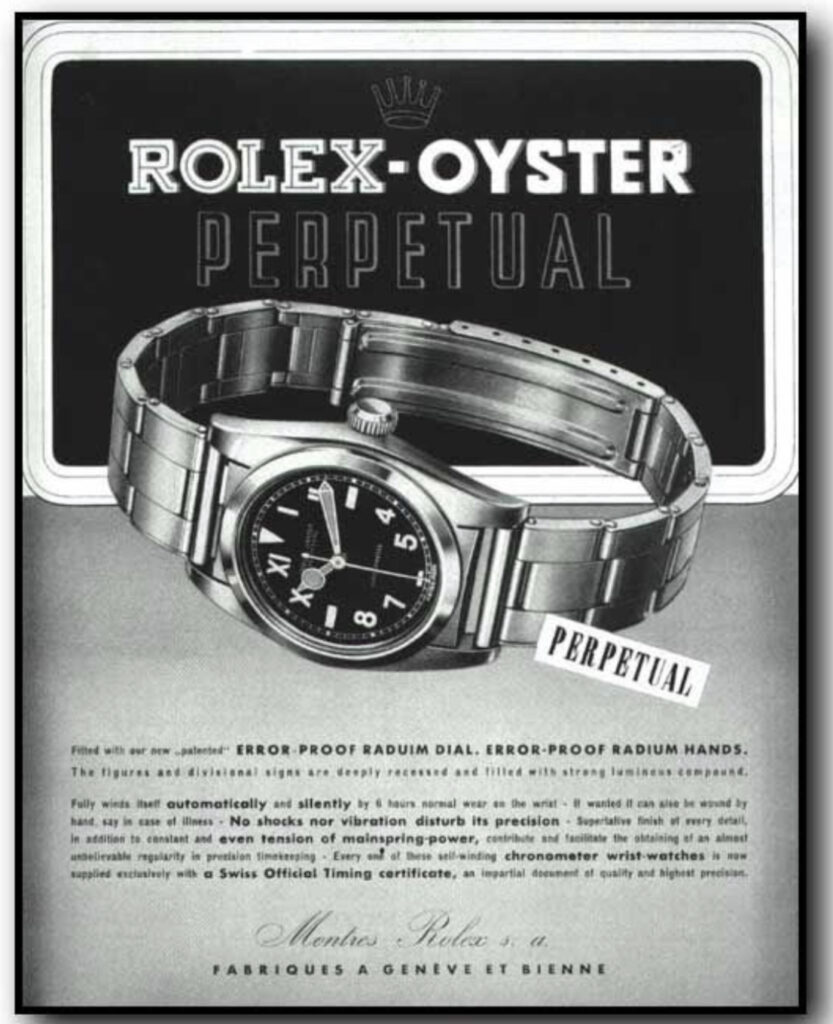
(On the dial of most Rolex sports watches from the 1930s onwards, ‘Oyster Perpetual’. Credit: Rolex.)
And Rolex, being the clever marketers that they were, took full advantage.
‘Oyster Perpetual’ was their way of marketing a watch that was both waterproof and self-winding. These two words would give buyers the confidence that they would own something that no other brand was capable of delivering. At least not as accurately and precisely as a Rolex. The reality and the perception was – that in early 1950’s – Rolex dominated this category.
In 1950 it would bring out the true masterpiece: the celebrated ref 6062 the oyster version of the triple calendar moon phase. The 6062 remains the quintessential elegant but yet sportive Rolex today with the most famous version being the Bao Dai.
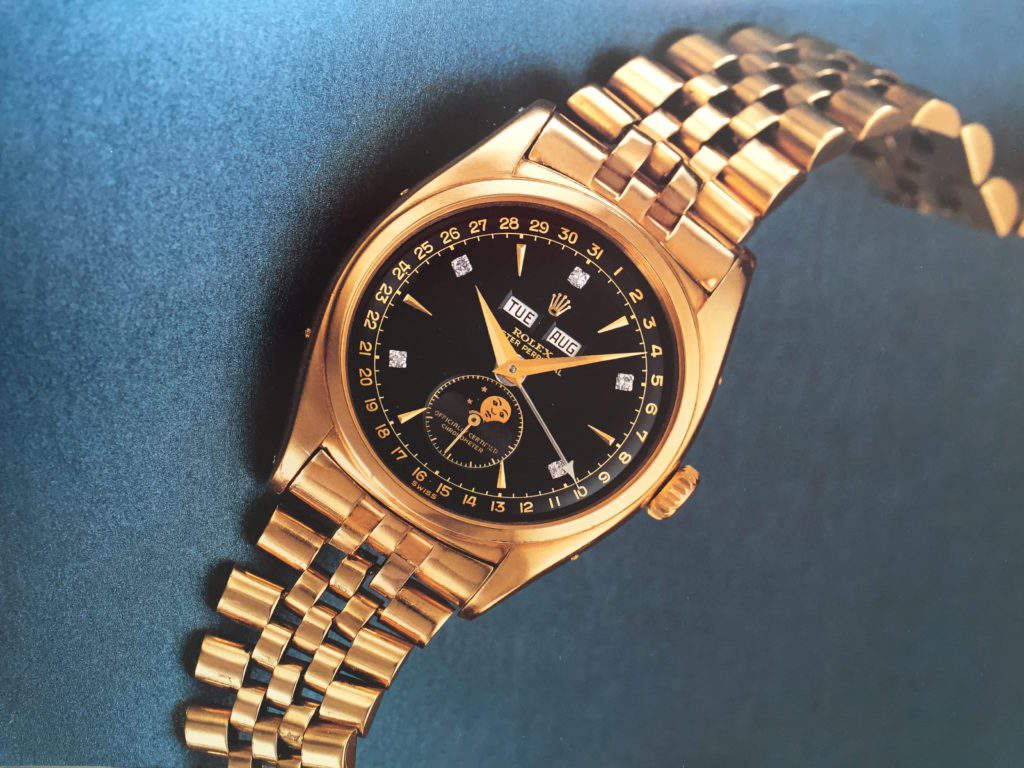
(Credit: Phillips de Pury -The Rolex 6062 remains the icon of all sports elegant watches Rolex ever made).
For this post, however, I will concentrate on ‘time only’ models and leave the complicated models like the 6062 (which I covered extensively in other posts- see owners 6062 and black dials as well as how to spoke a fake 6062) out. Allow me to show you some models which highlight the skill of Rolex in making some of the most beautiful ‘sportive elegant’ watches.
There is no particular model which starts this trend of sports elegance, so the watches I show will be done in groups. We start off with the Explorer dials & Star dials in Part 1. In Part 2 we look at ‘Enamel dials‘. In the last Part 3 we take a look at ‘Black lacquer dials‘.
*(Credit: Time & Watches – the history of Eterna for the document). Additionally the 270 degrees rotor rotation comes from a reliable source I have spoken to in the watch world).
The Explorer dials
Let me get straight to the point: For me, personally, one of the most beautiful watches Rolex made are the ‘Explorer dials‘ in gold.
It is the type of watch in terms of elegance you would have expected Vacheron Constantin, Audemars or Patek to make back then. But they didn’t. And they couldn’t. Rolex made it and today these watches stand out for their exclusivity, rarity, and beauty. They have this ‘sportive elegance’ that was unique in the market. No other brand made something remotely similar.
They are found in references 6098, 6099 and 6298 and 5029. Sometimes they are called ‘large bubble backs’ due to their large case size (36mm) versus the 31-32mm found in normal bubblebacks. These watches are my definition of sports elegance.
It is important to emphasize, that most large bubblebacks don’t carry explorer dials. The majority just have normal indexes on the dial and can be honeycomb or not. This watch is a good example of what I mean. A 6285 large bubbleback with regular honeycomb dial in gold. This alone is a super rare watch. But an explorer dial version takes rarity and exclusivity to a whole other level. I have chosen to concentrate only on Explorer dials as I find them optically speaking the most beautiful dials. This is my personal opinion.
We start with an unusual beast, and maybe the ‘unicorn’ among explorer dials, as it is the only known explorer dial in pink gold that sold at auction publicly:
A 1951 Rolex ref 6099 with honeycomb and explorer dial in pink gold and oyster case with self winding nickel lever movement (Cal A296). Serial Nr 740 xxx. Size is a large 36mm.
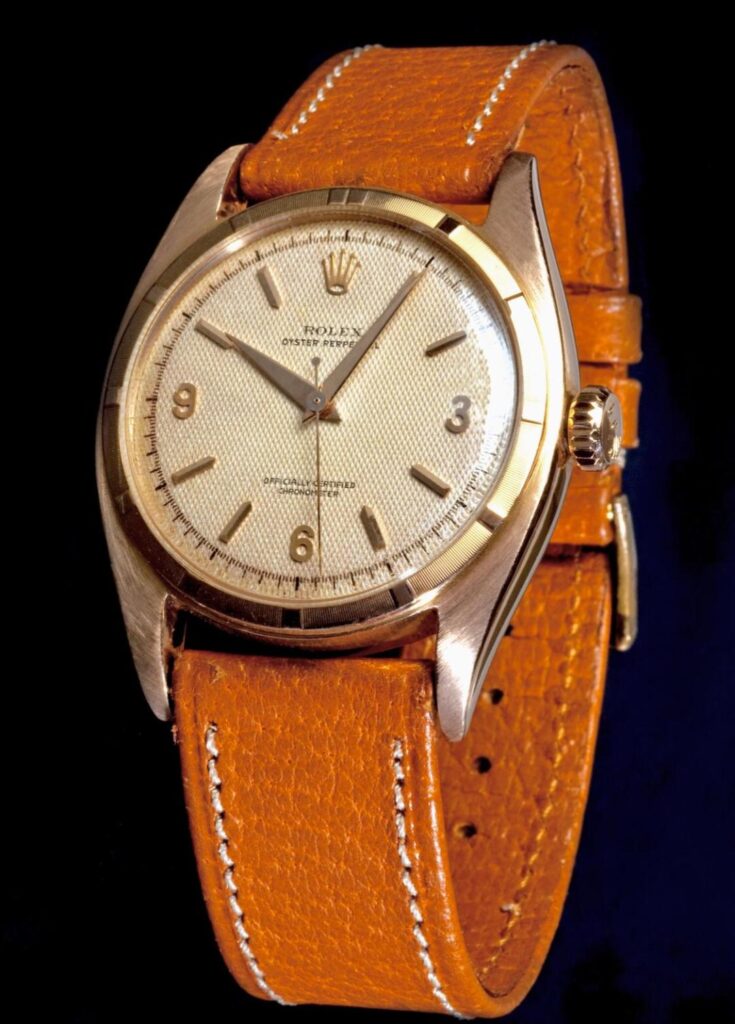
(Credit: John Goldberger).
You immediately notice pink gold case and the honeycomb dial and the applied indexes also made of pink gold with explorer dial layout. Undoubtedly very costly and time consuming to make. I presume, like many of the finest Rolex watches in the period, this was made for the South and Latin American market, which were booming in the early 1950s.
So far, it is the only known Explorer dial watch, made in pink gold housed in an oversize 36mm oyster case that has a public record.
Automatic perpetual movement (Cal A 296) and waterproof oyster case below all from 1951, long before Patek was coming out with the 2526 (which appeared in 1953).
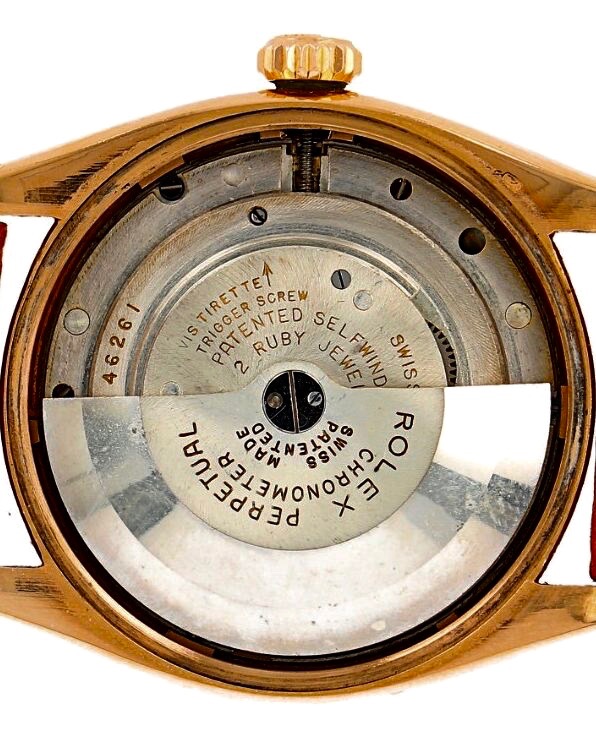
(Credit: Davide Parmegiani).
Notice the reference 6098 was crossed out and put 6099 (this is not unusual with Rolex) – see picture below.
The ref 6099 is extremely rare (even without explorer dial). The watch above is the only known version in pink gold with Explorer dial. In the past 11 years only one 6099 with explorer dial has turned up at auction and sold for CHF 20’000 in 2009 at Christies.
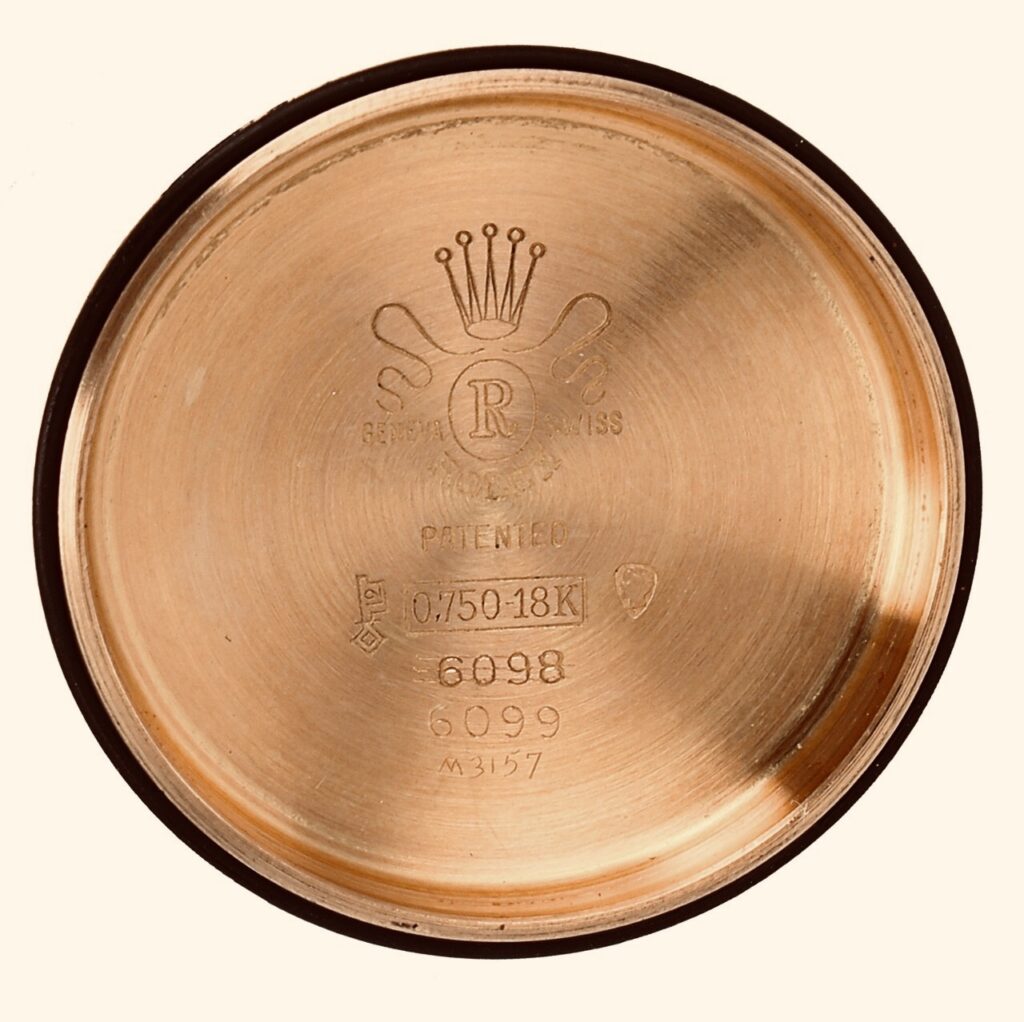
(Credit: Davide Parmegiani).
Staying with explorer dials, we move on to Ref 6098 and 6298.
The 6098 and 6298 are very similar to the 6099. They all were available with honeycomb, explorer dial with automatic movement. What I have found with my research on these references (6098 & 6298), is that relatively many of them were sold through the retailer Serpico Y Laino based in Caracas, Venezuela. This makes total sense.
During the 1950’s, Venezuela was a very prosperous and rich country and what better place than to sell Rolex elegant time only watches made out of gold and thus relatively expensive. It seems the retailer knew very well what wealthy Latin Americans wanted, because it choose the most luxurious version to sell.
A dial with applied gold indexes and numerals, on a honeycomb and explorer dial layout most commonly found in Sports watches in steel. Below, is a good example of what I mean: a fine Serpico Y Laino signed 1950’s Rolex 6098/6298 with honeycomb dial. Serial Nr is 739′ xxx. Size is 36mm.
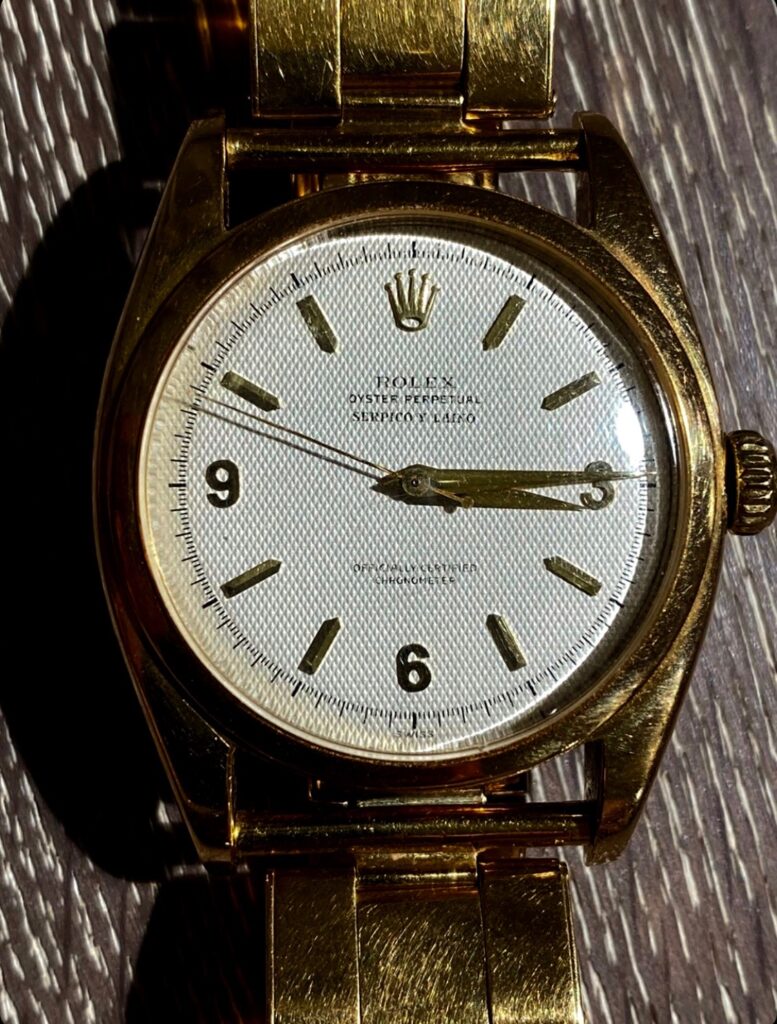
(Credit: Comex8 /HK based collector).
Another splendid example I found doing my research- is below. It is a 1951 Rolex 6098. Size 36mm.
It sold at Antiquorum back in 2009 for CHF 10’800. Already back then, these so-called ‘large bubble backs‘ were selling for far higher than the estimate. The market knew every well, already more than a decade ago, what a beautiful time only Rolex looks like. (Unlike the 6099 this watch carries the Cal 775). Unfortunately serial Nr is unknown to me.

(Credit: Antiquorum).
This watch also came with the original and signed bracelet S&L. What a marvellous piece, a good example of a bracelet making the watch even more special.

Only one year later, in 2010, Antiquorum would sell another 6098 with Serpico signed dial with serial Nr 7xxx xxx in 2010 for CHF12’000. I wish I knew back then what I know now. Serial Nr 739 xxx. Again 36mm.
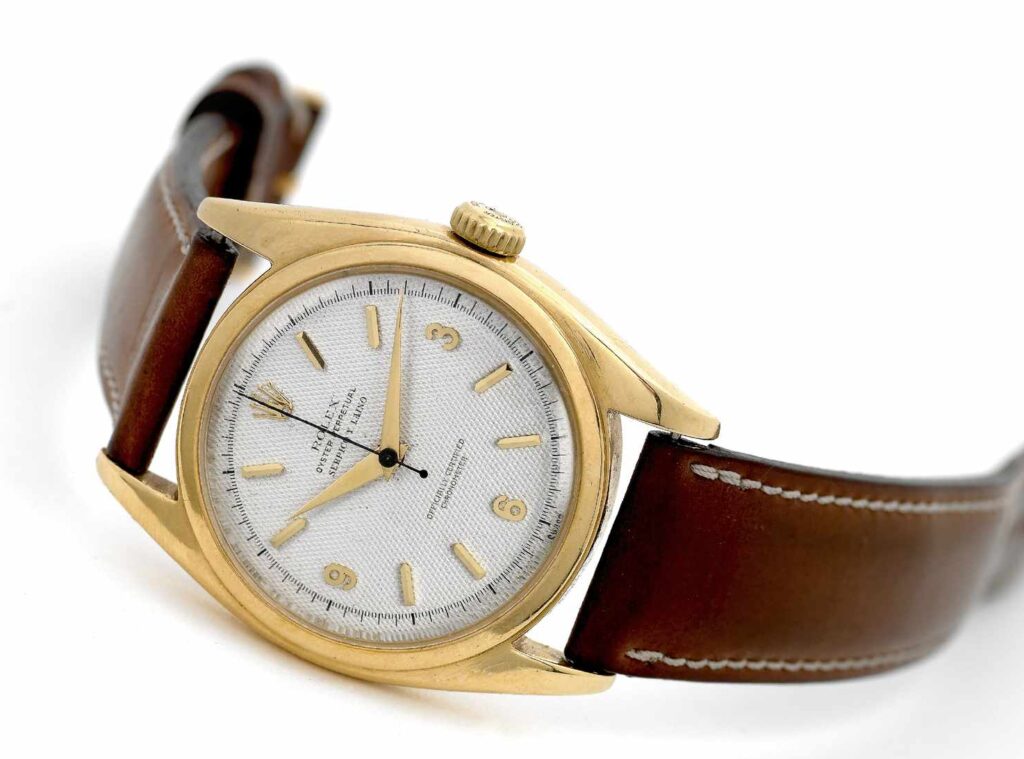
(Credit: Antiquorum).
The next Explorer dial 6098 I show doesn’t carry much weight, due to the lack of information I have on the watch.
But since the dial appears to be correct and it is a large bubble back (6098 likely) with a size 36mm, I thought it was worth including. It is taken from the Instagram of long standing Italian author and dealer Stefano Mazzariol. All credit is his for the picture. Again I don’t know the serial number nor have I seen the watch, but the picture of the dial is worth including in my opinion.
The font of the writing on the dial and layout all appears to be correct. A nice explorer dial large bubble back, probably ref 6098.
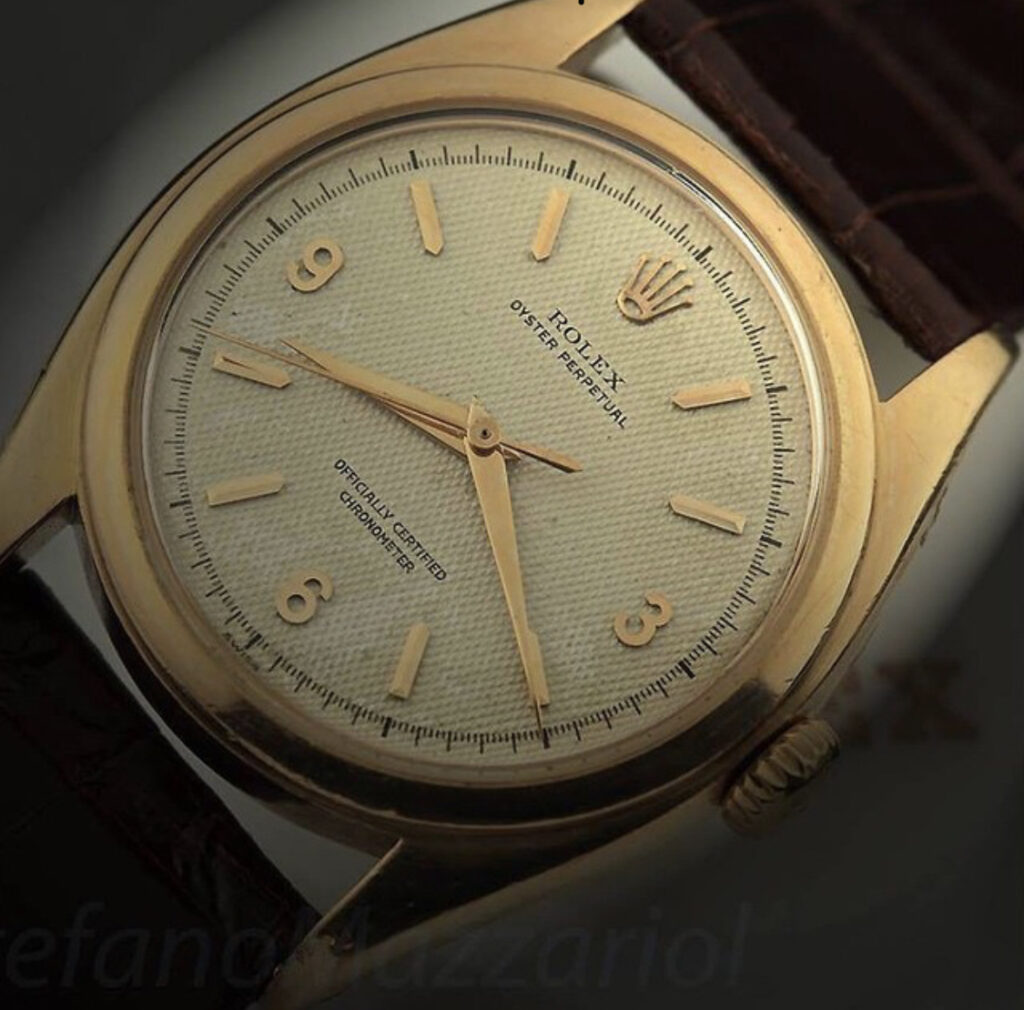
The next two ‘explorer dial’ Rolex that are important to show are a pair of 1949/1950 Rolex ref 5029.
Like the ref 6099, the ref 5029 is also considered a unicorn as there is only one known explorer dial version with honeycomb dial. Given the early serial number of 650 xxx, we can assume it was made before most gold 6098 that I have shown above. Size is 35mm.

(Credit: Meridiane /Andrea Foffi)
Like the later 6098 and 6298, all are known by collectors as large bubble backs. The details of this watch and principles remain the same as the others I have shown above. Honeycomb dial, applied gold indexes and explorer dial layout. Oyster case and self winding perpetual movement. The only notable difference is the bezel which is ‘engined turned’ as opposed to the smooth bezel found in 6098 /6298 explorer dials.
The Ref 5029 is extremely rare and I could only find two examples in all my research that has come for auction in recent years. Size seems to be 35mm (1mm smaller than 6098/6298).
In 2015 Phillips sold a 1950/51 Rolex Ref 5029 for CHF 40’000.
What is interesting to see is that in 2015, the market has started to recognise these important and rare watches. Prices started to climb nicely from the earlier examples of 2009/2010 for 6098 / 6298 which I have shown (even if the ref is different – they are essentially the same watches). Below another picture of this fabulous watch, that came from the well known Italian dealer, Andrea Foffi.
It comes as no surprise that this watch below is the same watch that was sold by Phillips watches in 2015.
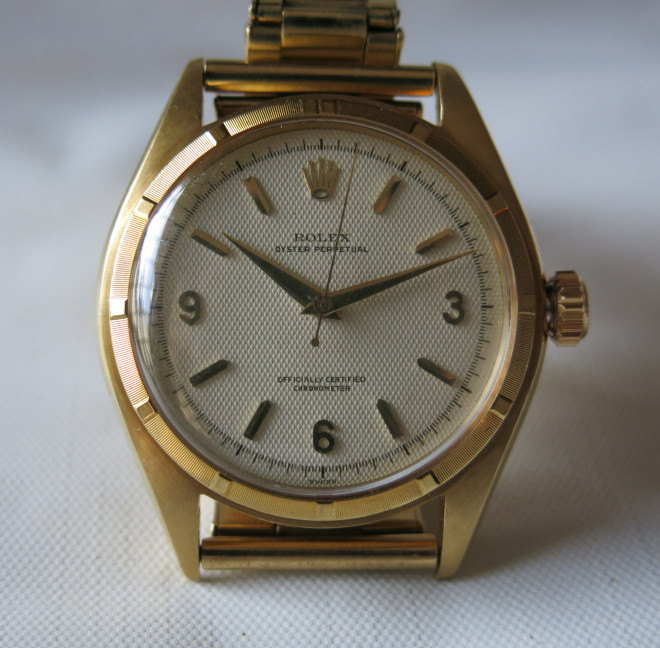
(Credit: Meridianae /Andrea Foffi)
The other Rolex 5029 that I want to point out can be accepted as an explorer dial even if the dial layout is somewhat different (for me a real explorer dial is 3,6, 9 layout only) but without the honeycomb.
From its appearance it seems to be an earlier version (at least the dial) than the watch above, even if the serial number is later. It is a 1949 Rolex Ref 5029 with serial Nr 673′ xxx. Size is 35mm.
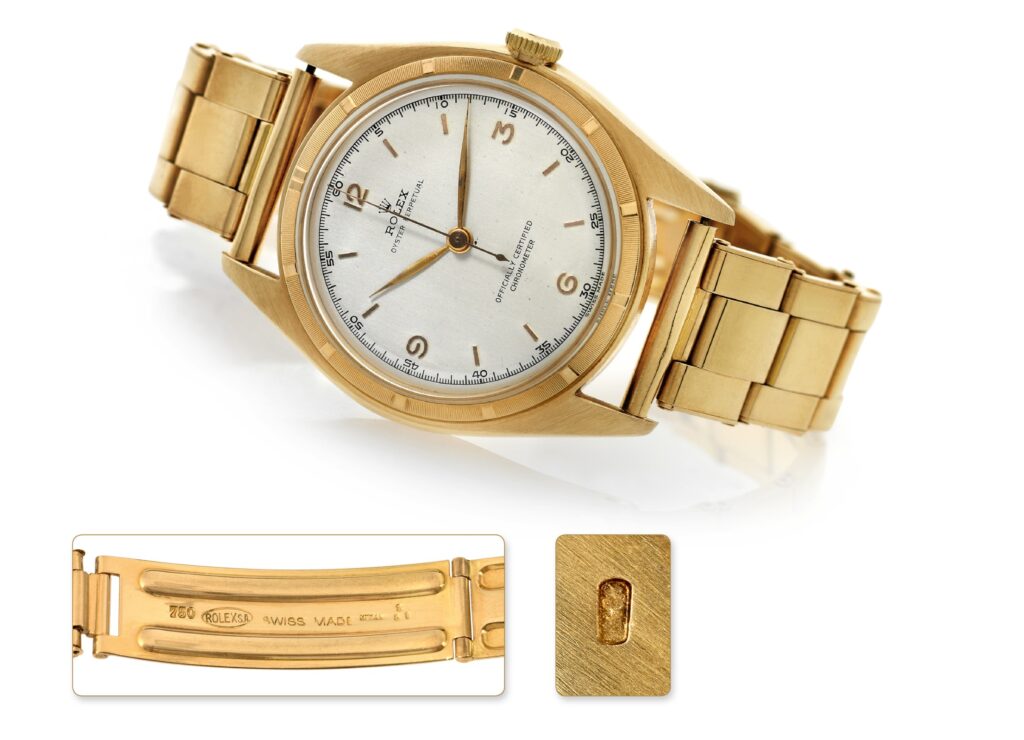
(Credit: Antiquorum).
There is much that is different about this watch, starting from the Rolex crown, to the font of the dial. The leaf hands and 5 minute counter are also seldom seen on explorer dial watches. As far as the case is concerned, this watch has an engine turned bezel and is in pink gold.
I personally prefer the honeycomb versions but this watch is important and beautiful enough to include it in this report. It was sold at Antiquorum in 2012 way above its high estimate (CHF20k) for CHF 28’750. Undoubtedly the fine condition of the case (see stamp) and pink gold bracelet with correct date (2/51) made this a trophy watch for the Rolex collector.
The last explorer dial and earliest version known to sell publicly that I wanted to point out is from a sale in 2002.
It was sold at Antiquorum for a sum of CHF 6’300 back in 2002. Given the nice dial layout and watch I thought it worth including in this report.
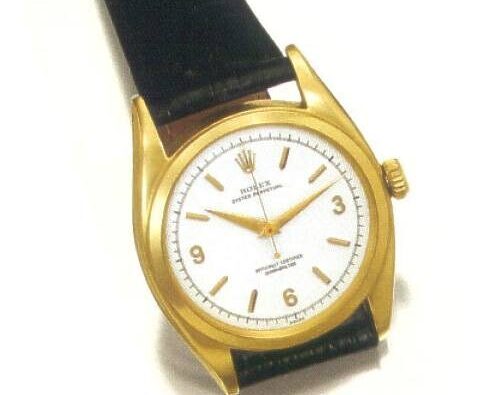
(Credit: Antiquorum).
Concluding thoughts
The explorer dial watches Ref 5029, 6098, 6099 and 6298 above, belong to the most sportive of the ‘time only’ but elegant gold watches Rolex made in the 1950’s. It was presumably made and sold to the connoisseur of fine watches back in the early 1950’s who wanted something far more exclusive (and expensive) than a steel sports watches like 6298 or 6098.
Rolex essentially had this market of ‘sports elegance’ to themselves in the early 1950’s. Not Patek, nor Vacheron or Audemars, or any other high end name in watches, could compete with Rolex in my personal view. Cleverly marketed under the words ‘Oyster’ and ‘Perpetual’ – Rolex dominated this catagory of ‘sports elegance’.
Today, because of the very brief period of production and beauty, they remain sought after but elusive watches. In my view they belong in any serious Rolex collection. Unfortunately, prices have increased to a multiple of 5-6x today from the 2009/2010 examples I show (depending on condition even more). However, I still find them undervalued relative to their scarcity and beauty.
If you can find one, buy it (or alert me – so I can do so).
Star dials
You can’t talk about Rolex and sportive elegance without including the star dial ‘time only’ watches, especially the 6098 cased in gold.
I have covered the Star dial Rolex watches extensively in another post so I will keep this relatively short. Instead, I will expand on one model of the star dials, the 6098 (and black dial 6088).
The 6098 star dial belongs to the pinnacle of Rolex artistic capabilities, housed in a sportive oyster case and self-winding perpetual movement. Rolex targeted the connoisseur of fine watches (as the advertisement below states) and this was a watch, that in my view, competed with Vacheron and Patek, especially their fancy shaped cased watches at the time.
But, unlike Vacheron or Patek, only Rolex was able to offer a self-winding sportive mechanism housed in an oyster case.
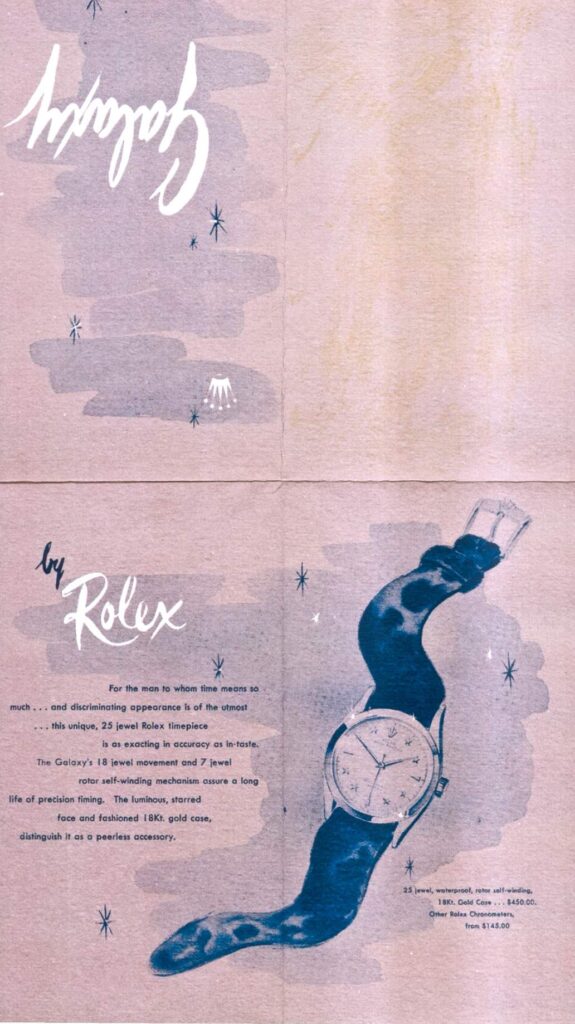
What is interesting to note, is just how much more expensive gold watches were compared to the steel ones. A more than 300% premium! Just look at the advert above – the massive price difference of common steel watches ($145) and those of gold ($450).
Like the Explorer dial watches above, the 6098 star dial was often found on a honeycomb dial, where Rolex would carefully mount the stars by hand.

(Credit: John Goldberger).
Notice how similar these honeycomb star dials are to the Explorer type dials. Both have honeycomb as a base.
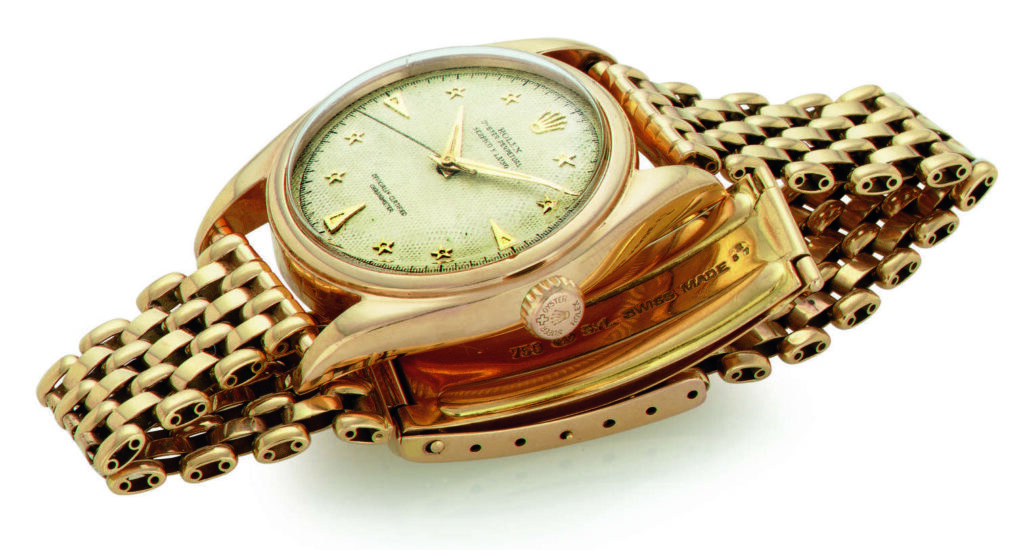
(Credit: Antiquorum).
Another beautiful star dial below. Strong case and strong dial condition.
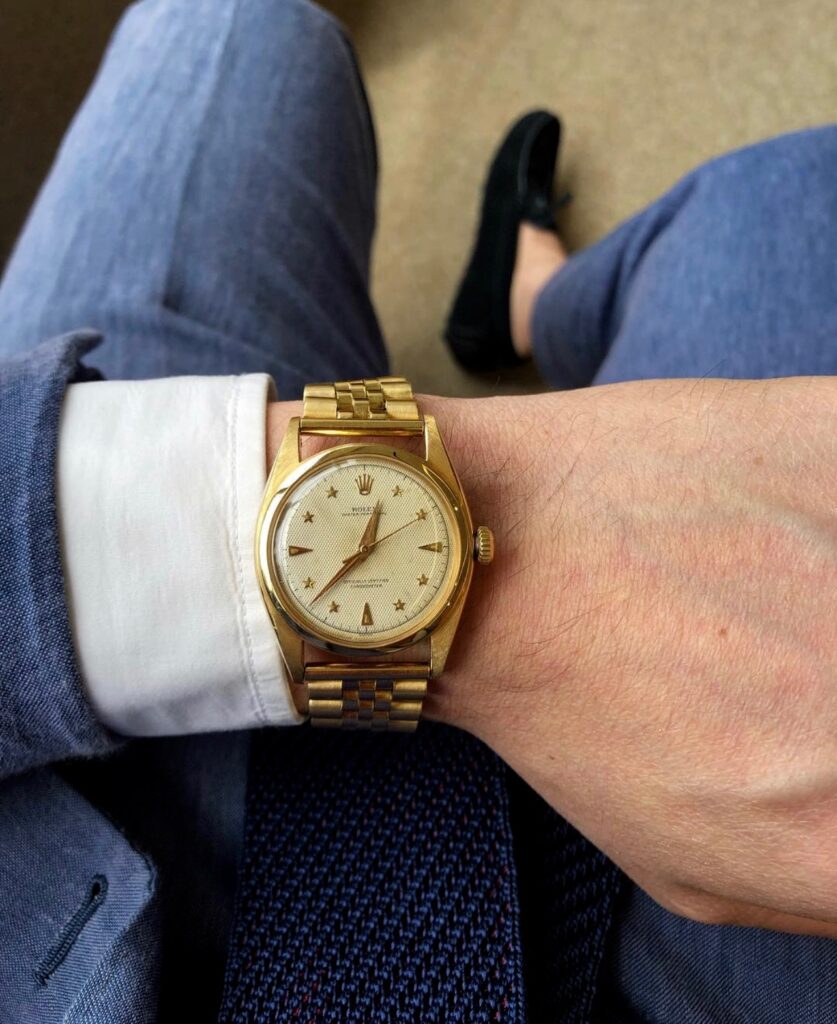
(Credit:Singaporean private collector).
The last star dial I show is just the dial.
It is such a powerful watch. The stars as hour indexes, nothing more and nothing less. This is Rolex at it’s height of artistic capabilities!
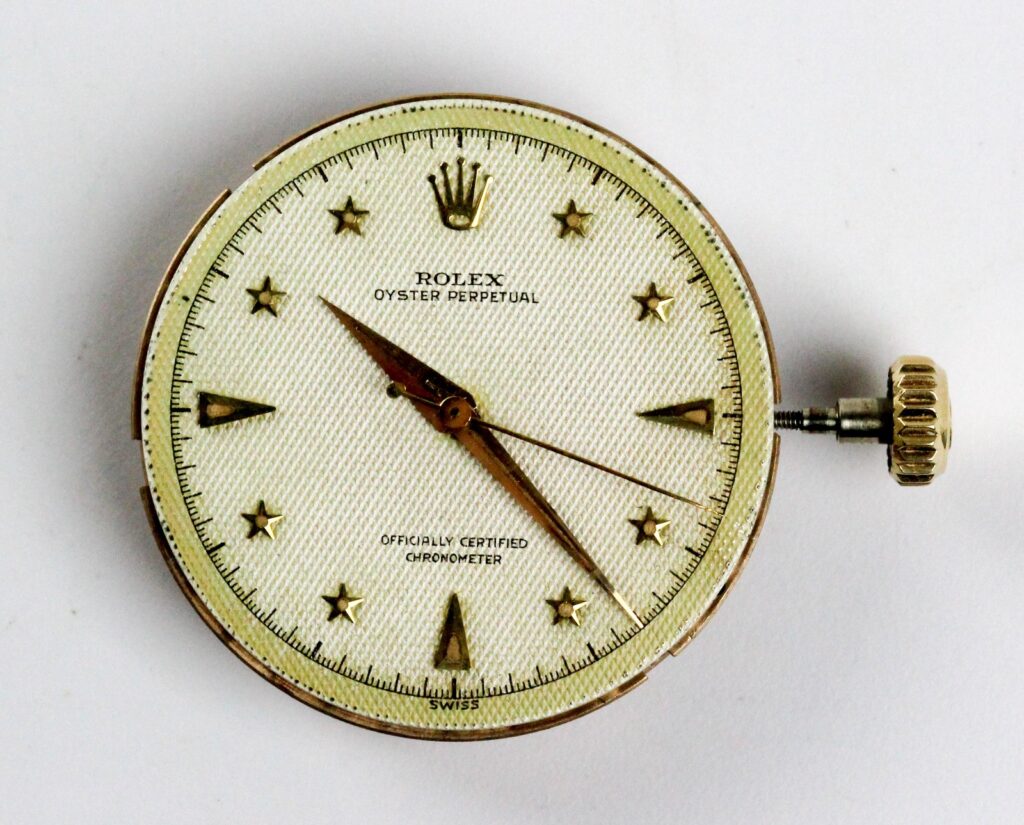
(Credit: Mentawatches).
On the most exclusive versions, the black dial, Rolex would move towards the gilt and lacquer dials seen later in sportswatches (and black lacquer dial watches which we cover in Part 3). Today it represents a trophy watch for all watch collectors for its beauty, rarity and playfulness.
The king of the star dials oyster case, below, which already back in 2006 sold for CHF 120’000.
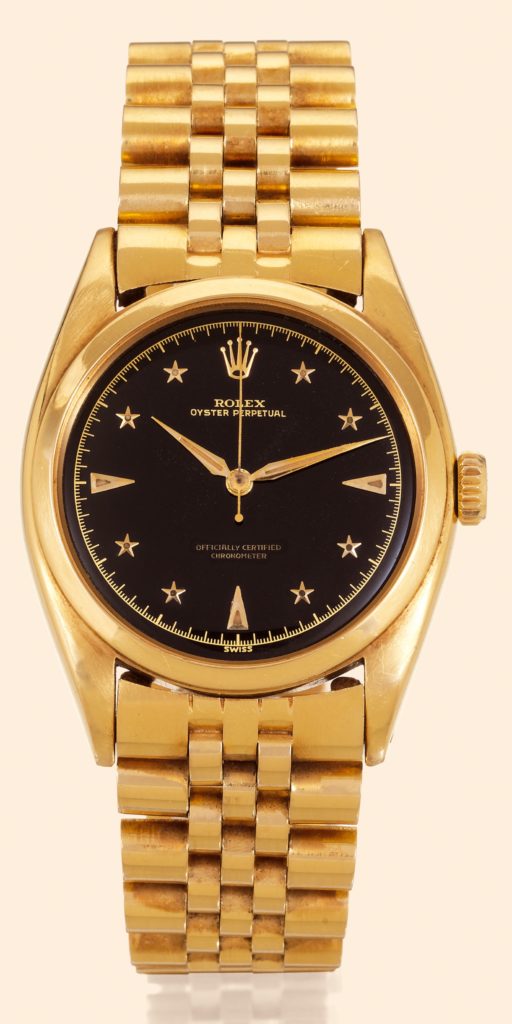
(Credit: Antiquorum).
One of my favourite shots of the ‘king’ of all star dial watches. The only watch to carry its own reference, 6088. Phillips watches would end up selling this watch in 2017 for a record CHF 670’000.
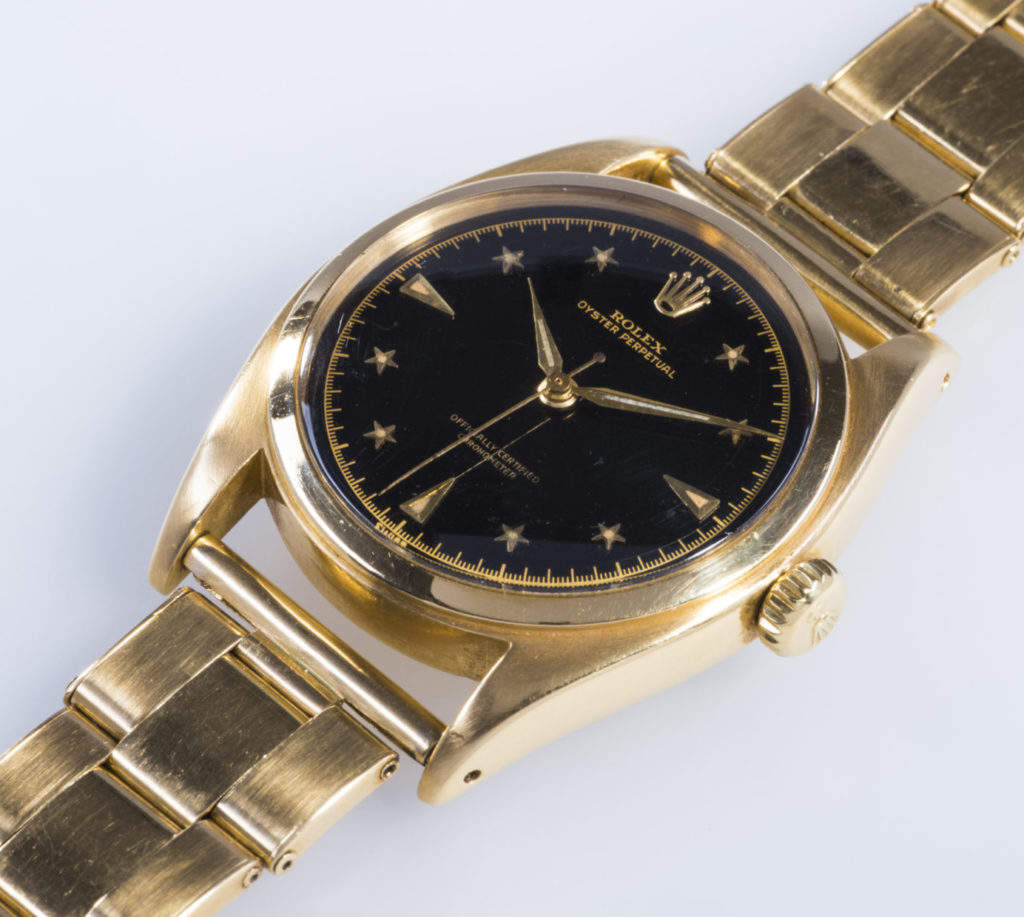
(Credit: Phillipswatches).
Last picture showing the purity and attractiveness of these time only watches star dial ‘Galaxy watches’.
Rolex was on top of the world at this point. It was producing watches that Vacheron and Patek could not or would not do (as Rolex had the oyster perpetual patent) but also making watches that were the most creative and inspiring out of any brand back then!
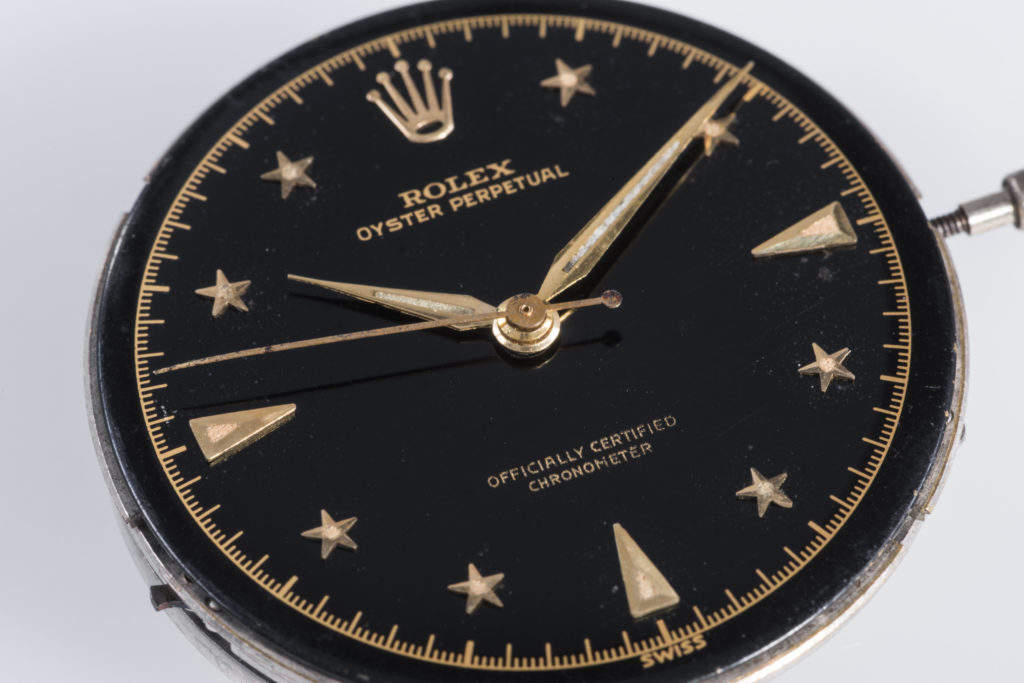
(Credit: Phillipswatches).
Concluding thoughts
Again, it is worth repeating once more: The ‘sports elegance market‘ in high-end watches, was dominated by Rolex who could offer the sophisticated gentlemen an elegant sports watch.
What do I mean by this? A sports watch that was versatile as in the oyster case for water resistance, luminous dial for better legibility, self-winding perpetual mechanism for continuous time reading without interruption. But also elegance in the case material (gold), dial layout and dial version (stars or explorer dial). No other brand could offer this (at least not according to my best knowledge).
Rolex ruled this niche market of ‘sports elegance‘ for a good five years, on the high end, before Patek would enter it and then Rolex would decide to focus their attention to sports models which was once again a shrewd decision financially speaking. For collectors today this means one thing. Rarity.
That is why, I don’t think it is a wrong move for collectors to buy star dials or explorer dials of this period. Rolex was on top of the world, alone in its ability to provide the most sophisticated gentlemen a watch that had everything a demanding connaisseur could ask for.
NB: In Part 2 we look at Enamel dials. For full disclosure purposes I have, or might have, a personal interest in one of the watches above in terms of ownership.
